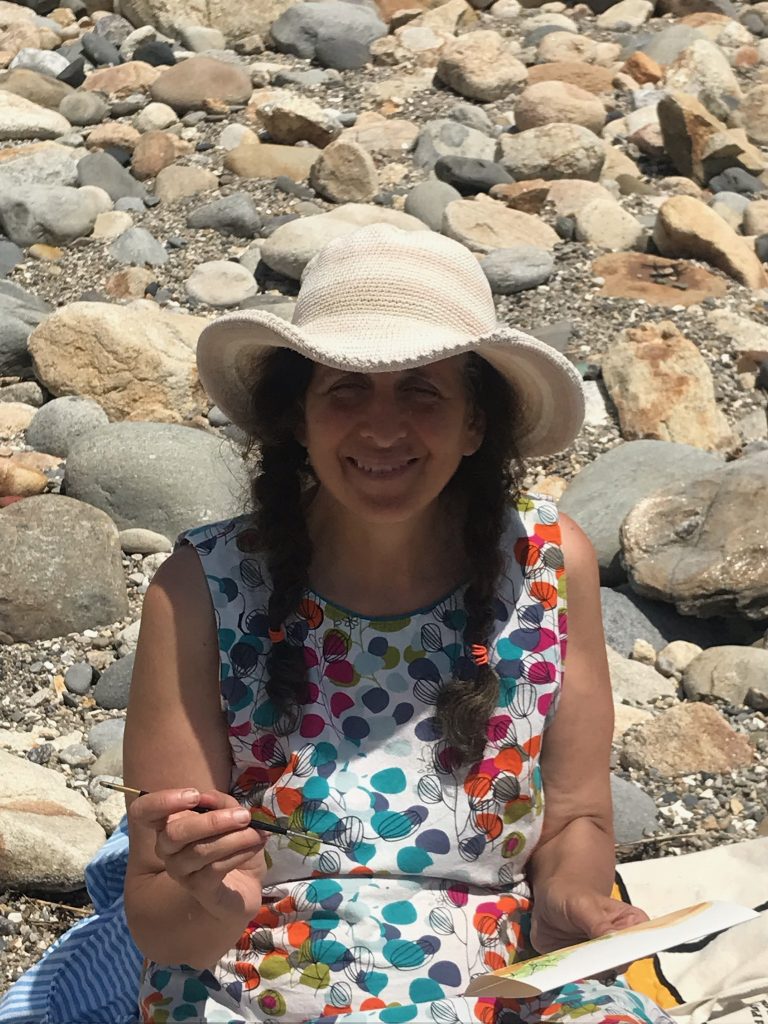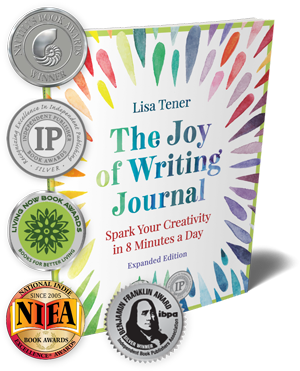When my sister Sara visited last week, we spent our most luxurious moments painting small watercolors on my deck while listening to birdsong and later sitting on the beach, painting a favorite cove as the sunlight sparkled on the ocean and huge waves sprayed off the rocks the day of the full moon.
Creative Lessons

While I’m not wild about any of the paintings I created, I thoroughly enjoyed the time spent painting, picking up tips from my talented sister, being inspired by nature and each other, laughing and learning new things about painting.
And, as you might expect from me, I couldn’t help but parlay those lessons into tips that apply to writing and other creative ventures. Here goes:
#1 Small Works Make it Easy to Experiment.
Because we used small 5 x 7 watercolor paper intended for use as greeting cards, we could create three or four paintings in a sitting. Each one enabled different experiments in color, shading, brush use, contrast, composition (oops, I forgot about that one a couple of times) and more.
Likewise, when you give yourself time for smaller projects, like writing poetry, journaling or creating short stories, you can experiment and learn things in smaller bursts. You might play with rhythm, word-play, syntax, alliteration, character development, dialogue, point of view or other experiments. These may well find their way into your bigger work, without having to experiment on the bigger work itself.
#2 “Go for an impression, not the precision of a photograph.”

Have you ever read anything that gave so much detail you got lost or bored? One great skill of the writer is to pick out the very particulars that will make your scene or character come to life, without providing every last detail, photograph-style.
Put in too many details and we don’t know where to look to understand the character or to envision the scene. When you share just the right elements, you convey exactly what you want readers to grok.
Think broad brush strokes. What small peculiarity reveals the most about a character? Her snarky expressions? The way she struts? His long pauses? Their nervous tics?
#3 Have a vision, structure, a big picture plan.
As we painted, my sister reminded me about composition and the rule of thirds: “Break your page up into thirds—both horizontally and vertically.” This means the sky should take up 1/3 or 2/3 of the canvas, not half, for example. I forgot a couple times and it made the painting weaker.
For writing, you don’t always need a plan. Some writing just flows onto the page—the “happy accident.” However, for longer works, like a book, it pays to have a plan, even if that plan transforms over time.
Or if you might start with that amazing download (like the 30 or so prompts I wrote in an hour that became the seeds for The Joy of Writing Journal). But then, you need a vision and structure for how to integrate and make the most of that initial “download.” At least, I did. I often see that same need for vision and structure in my clients’ work.
#4 Leave White Space.
In watercolor, we often leave white space that can become the tops of waves or a place for contrasting colored detail at the end.
Writing is more forgiving. You can make infinite changes. However, there is something to the idea of space. For example. I often suggest that nonfiction writers write from what they know in a state of flow. You can later do more research and expand the work; but if you try to start with every detail and include all the research from the beginning, you can easily get stuck in minutiae and never get to the actual writing!
#5 Employ a light touch when mixing colors.
When you mix too many colors together, you get a muddy mess. In fact, if you mix colors to leave a bit of variety (a dot of yellow or red in the brownish green, for example), your painting will hold more interest and look more real.
With writing, avoid the mixed metaphors and clichés. Precise language will help your reader see what you see and focus where you want them to focus.
#6 Practice is its own reward.
Like I said, I’m not in love with any one of the small paintings I created, but I do love aspects of each of the cards. In one, I learned how to make water sparkle. In another, I learned which brush makes the best short grass and tree leaves. In another I experimented with color and shadow.
I’m not sure these cards are even worthy of using as a greeting card, but the output doesn’t matter as much as the time I allowed myself to play, create and enjoy my sister. We reminisced about how painting made us feel particularly close to our mother.
It’s well and good to write for a particular purpose (as in this blog post I am writing now!). But it’s also important to just write for enjoyment. To play. Your inner muse will reward you with more inspiration and success when you make time for just practicing.
#7 Create in community from time to time!
There is something quite magical about creating with others. Writing can be a lonely act, which is sometimes fine. Yet, it can feel especially refreshing and energizing to experience the camaraderie of fellow writers, to know you’re not alone and to work off the group energy.
In fact, I wrote 96% of this blog post during my Get Your Writing Done call last week (yes, even the teacher gets to write!).
Consider joining us to get your own writing done, and experience a heightened sense of joy as you write. We meet Thursdays at 11:30 ET (8:30 am PT) and I’m also thinking of adding an evening session with another teacher or two this fall. Find out more here. If you are interested in an evening class, comment below or shoot me an email to let me know which times and days of the week will work best for you this fall.


